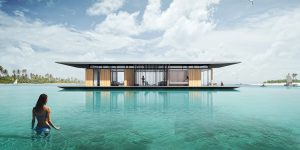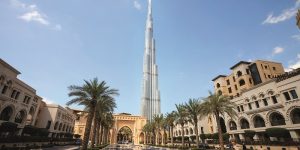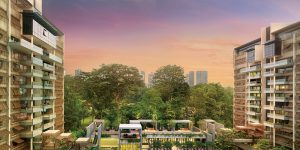8 Urban Residences with Sky Gardens
Architects around the world hope to create a new typology for urban living through the use of sky gardens.
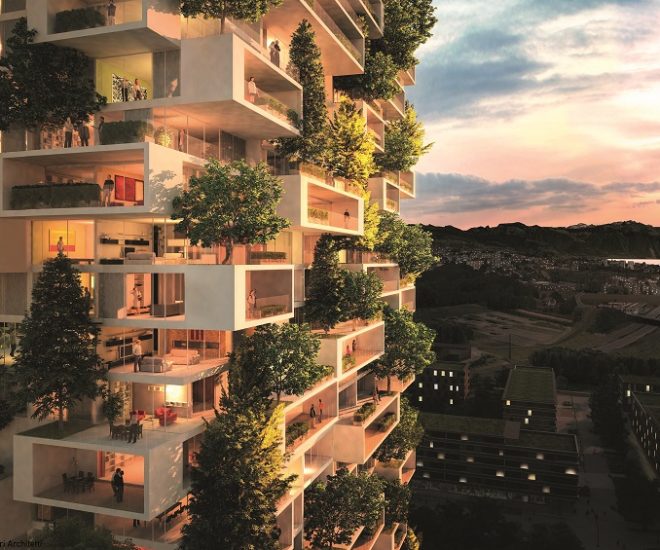
A private garden, a backyard with trees and flowers, these are luxuries that city dwellers must sacrifice for the conveniences of modern urban living. At least, that has been the prevailing notion. However, some of today’s architects view the matter quite differently.
“There is a huge disconnect between how we live in our cities and what we need, as human beings, for quality of life,” says Eran Chen, Founder and Executive Director at ODA studio in New York. “I don’t think that we should be forced to choose between enduring life in the city, or escaping to suburban areas.”

East 44th Street in New York City with a view of One World Trade Center and Sky Garden Terrace
Chen’s solution to this disconnect is to combine the two typologies. His studio recently released plans for East 44th Street, a slender residential tower in Midtown Manhattan that has open floors for sky gardens. By “stretching” the building vertically beyond its original program, the studio was able to create gaps, 16 feet in height, between every two floors. The gaps in the building will contain full floor sculptural gardens equal to the footprint of the building and will be directly accessible from each apartment. In other words, each 2,800 sq. ft. apartment will have 1,400 sq. ft. of open private garden. The tower will contain 44 residential units in total, with one, two or three-bedroom layouts and a duplex penthouse.
Other Manhattan studios are also inverting the traditional sealed box approach to tower design. Nearby on East 37th street, a slim residential tower proposed by Perkins + Will, will have built-in parks and an outdoor cinema. The concept for the 700 foot tower, which features four open-air sky parks at various heights, was to take the urban fabric of Greenwich Village, where row houses will have a small park at the end of the block, and tip it vertically. “It creates this balance of your own private apartment and shared outdoor greenery that becomes almost like that park at the end of the street, except in a vertical way,” says Robert Goodwin, design principal at Perkin + Will.
Designing for dense future cities that will house an increasing number of inhabitants raises a number of questions. “How do you create livability in a dense city?” Goodwin says. “How do you make tall buildings that people really want to live in?” This is a challenge that confronts architects around the world. Today, many design innovative new projects that aim to achieve densification without compromising on quality of life.

Cloud Corridor, Los Angeles
In Los Angeles, Chinese studio MAD has designed plans for Cloud Corridor, a high-density building with nine interconnected residential towers, that turns disparate neighborhoods into a vertical village with public spaces and gardens in the sky. The tower is meant to address the concern of suburban sprawl and also aims to connect people and nature. “The garden patios and courtyards provide a lush environment amid the surrounding urban density, and provide a retreat from the everyday among nature,” the studio says. The elevated corridors and multi-level garden patios shape the city skyline and provide viewing platforms for residents to overlook the city below and the natural landscapes beyond.
In Dubai, a new project called Suites in the Skai has 60 storeys with more than 500 apartments featuring their own sky gardens. Some also have swimming pools. Hussam Abdelghany, the associated design director at Atkins Global, says the sky gardens at the tower, which is due for completion in 2017, will increase shade and encourage wind penetration, producing a microclimate that will make the gardens a pleasant experience for most of the year, even when it is hot.
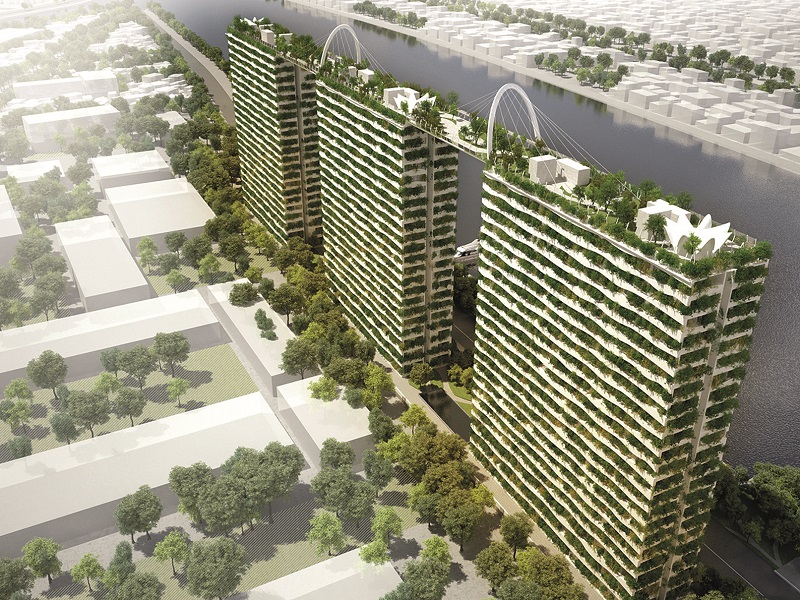
Diamond Lotus, Ho Chi Minh City
In Vietnam, studio Vo Trong Nghia Architects recently unveiled plans for the Diamond Lotus project, three 22 storey towers located on a finger of land between two rivers outside of Ho Chi Minh City. The project, which includes 720 residences, will be shielded from the tropical sunlight by swathes of bamboo and are connected via a planted roof garden that can be accessed from each apartment. “The connected roof provides the residents with a large green space, which rarely occurs in the city,” the studio said. While other developments are expediting the loss of greenery in the city, the architects say the green bridge and green façade of Diamond Lotus are not only a dedication to the comfort of inhabitants, but also “a contribution to the landscape, appearing as a green screen in the city.”

Bosco Verticale
Allowing city dwellers to experience greenery and outdoor space is one factor motivating architects to incorporate sky gardens. But there are other advantages too. One of the first residential towers to incorporate sky gardens, Bosco Verticale, was designed by Italian architect Stefano Boeri as part of the rehabilitation of the historic district of Milan between Via De Castillia and Confalonieri. The scheme comprises two towers, both of which incorporate trees, and one which houses 400 condominium units. In addition to providing residents with their own leafy oasis, the trees help to mitigate smog, produce oxygen and moderate building temperatures in winter and summer. The plants also attenuate noise.

Tower of Cedars, Lausanne
Now Stefano Boeri has designed a new 384 foot tall residential building in Lausanne, Switzerland, that bears many similarities to the Bosco Verticale. Named Tower of Cedars, the project is set to house more than 100 trees, 6,000 shrubs and 18,000 perennials. The apartment units protrude from the structure and offer views toward Lake Geneva, while their roofs are designed to accommodate plants.
According to Boeri, the building in the Chavannes-Près-Renens district of the city will be the first tower in the world to be covered with evergreen trees, selected in part for their ability to withstand harsh climates, and also the environmental function of their leaves which absorb CO2 and produce oxygen. “With the Tower of Cedar Trees we will have the opportunity to realize a plain building that will have a great role in the Lausanne landscape. An architecture able to introduce a significant biodiversity of vegetal species in the middle of an important European city,” Boeri says. The tower will comprise 36 floors and include private residences, offices and commercial space. There will also be a gym and a rooftop restaurant.
While buildings with sky gardens easily invoke a sense of utopian wonder, they are not built without challenges, particularly when it comes to structural support. At the Bosco Verticale in Milan, the engineering team worked with botanists and horticulturalists to ensure that the structure could bear the load imposed by the plants. The steel-reinforced concrete balconies are designed to be 11 inches thick with 4.2 foot parapets.
Slender residential towers such as those proposed in Manhattan have small floor plates and architects must ensure the building porosity does not compromise the tower stability.
At East 44th street, ODA utilized structural lateral systems in addition to a central core that act as the main supporting spine. The initial design did not include beams as the floors were supported by the building’s core, but Eran Chen says this proved structurally challenging. “By adding the beams we created ‘sculptured gardens’ that doubled as a way to protect against inclement weather while still providing 360 degree views.” Each garden is effectively covered by the floor above it and is protected from rain and snow.
Chen says the garden gaps at East 44th street also serve to lessen the wind load impacting the building — other skinny skyscrapers accomplish this via unused gaps throughout the structure. And the expansive height of the garden space with also permit a suffusion of sunlight throughout the central core and perimeter. “We are used to seeing New York City’s towers as monolithic boxes usually housing corporate power. But today, as these towers become more residential, they do not need to have the same scale or design. They shouldn’t express the same thing,” he says. “When it comes to residential towers, they should all contain accessible outdoor space for all residents.”
Still, some critics argue that outdoor gardens at these heights is impractical in a city like New York, where temperatures drop well below freezing in winter months and the wind, which is known to howl down the avenues, would in this case howl both below and above you.
In London some critics allege that developers use the guarantee of lush green spaces to get building plans approved, but rarely deliver on their promise. At 20 Fenchurch Street early CGIs showed a storyboard of seductive images with residents mingling among cherry blossom from a soaring vantage point. The tower was given planning permission in an area never intended for tall buildings on the basis that it would deliver a public sky garden. Once complete, however, the garden amounted to nothing more than a few spindly trees in pot planters.
While down in Singapore, green design is on everyone’s mind when it comes to new architecture and not just to get buildings approved. The latest project by architect Christoph Ingenhoven is at the forefront of green technology. Ingenhoven Architects coined the term “Supergreen”. A concept they live and work by. Their definition of Supergreen: ‘an awareness of energy and resources, both in design, construction and operation and in the realization of the building and its use.’ Marina One was designed with this in mind. Located in the heart of Singapore, at Marina Bay. The two towers will be able to take advantage of rainwater harvesting, solar power and natural ventilation. Most importantly, at heart of the development is a 65,000 sq. ft. park, landscaped to fit its natural surroundings. Whether or not other future developments will follow suit to this extreme in Singapore, remains to be seen. However, Marina One is certainly taking being green, to the next level.
As with all new building trends, early incarnations will include hits and misses. It may take some time determine which types of sky gardens are truly used and enjoyed by residents. But architects like Chen are bullish about the potential for vertical parks to transform the contemporary urban reality. “We believe that true luxury evolved from the ability to have the best of multiple worlds without compromise, and in this tower, the best of urban living melds with the dream of a suburban backyard,” he says. “There’s going to be a time in New York City where living without a substantial outdoor space is just going to be unacceptable.”
Story Credits
Text by Sophie Kalkreuth & Robbie Wilson
This article was originally published in PALACE 15





